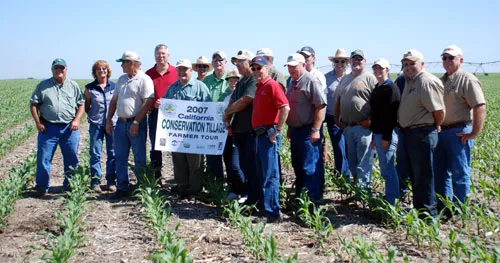
Recent research conducted by CT Workgroup members has shown the short-term potential of CT production systems to reduce production costs and resource use and to decrease particulate emissions by over 60% in cotton – tomato rotations and by over 80% in CT dairy forage production systems.
The CT Workgroup is currently very well positioned to lead the further development of reduced tillage alternatives in California’s Central Valley. However, financial support of its programs and initiatives is now needed at a level that far exceeds the modest extension education program budget it receives from the University of California Division of Agriculture and Natural Resources. Thus, the Workgroup is currently engaged in a major fundraising effort that is aimed at securing adequate, ongoing support of research and demonstration projects, equipment acquisition and sharing programs, technology transfer training and development of conservation incentives opportunities for CT farmers in California. We welcome your interest in our work.
Conservation tillage: A means for sustaining agriculture
Adoption of conservation tillage crop production practices may be a viable means for sustaining agriculture and improving air, water and soil quality in California’s Central Valley. In their many and varied forms, conservation tillage (CT) systems aim at reducing primary, intercrop tillage operations such as plowing, disking, ripping and chiseling. As a result, soil disturbance is minimized and tractor operations are reduced. As a consequence, fuel use, NOx, particulate matter and CO2 emissions as well as surface water runoff can be reduced, soil carbon sequestration can be increased, and overall farm profitability can be improved.
Conservation tillage production systems for a range of crops are widely used in other regions of the United States including the midwest and the southeast and they have become the standard production paradigm in much of South America. Reducing surface soil erosion and cutting production costs have been the primary reasons for adoption of CT in these areas. Equipment innovations, herbicides and widespread farmer and researcher experience have contributed to the fact that since 1997, on a nationwide basis, more cropland acres are farmed using conservation tillage practices than using standard tillage practices. Less than one percent of production acreage in California’s Central Valley, however, is currently farmed using CT practices largely because producers lack information and successful examples of CT systems are only now being developed here yet.
A number of factors are currently converging in the Central Valley that may, however, make CT alternatives increasingly relevant and attractive to producers. Recent escalating production costs have resulted in sharp declines in net farm income and these threaten long-term economic viability throughout the region. In addition, producers and the general public alike are increasingly concerned about air, water and soil quality in this region. Reducing production costs and improving environmental quality have thus become compelling and critical goals throughout the Central Valley basin.
